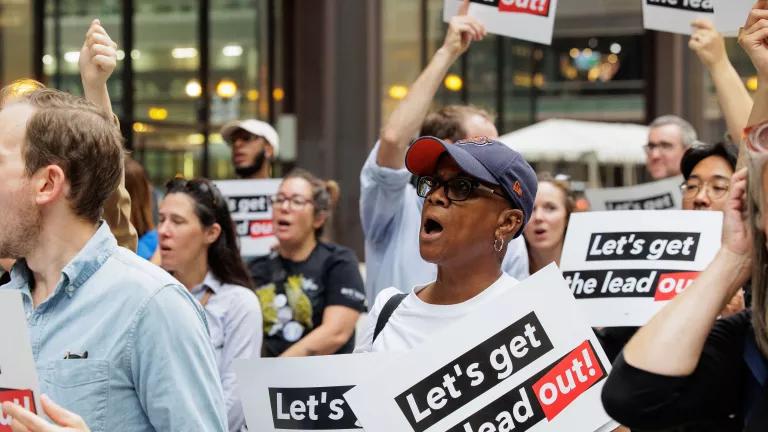EPA Wants Lead Pipes Out in a Decade: Chicagoans Could Wait 40+ Years
Chicago's lead pipes could be replaced by 2067 or later based on the EPA's Lead and Copper Rule Improvements proposal.

"Let's Get the Lead Out, Chicago!" rally participants holding signs that read, "Let's get the lead out!"
Eric Michael Clark for NRDC
The unveiling of the U.S. Environmental Protection Agency’s (EPA) Lead and Copper Rule Improvements (LCRI) proposal is a long-awaited milestone for water advocates across the country, but the proposal leaves much to be desired for Chicago residents. One key provision of the LCRI is requiring every state to replace its lead service lines in 10 years, but Chicago, whose lead pipe problem is more extensive than any other U.S. city, is only required to replace 8,000 to 10,000 pipes a year — getting an extension of 40 to 50 years to replace them all.
Prior to the EPA’s LCRI proposal, the Illinois Lead Service Line Replacement and Notification Act gave Chicago a 50-year timeline to replace its lead pipes (with the option for extensions up to 15 years). Despite the problematic replacement timeline, our legislators were ahead of the game by including provisions in our state law that are now outlined in the EPA’s LCRI proposal, such as mandating full lead service line replacements and requiring water utilities to track, report, and regularly update their lead pipe inventories.
We Must Shorten Chicago's Timeline
I am grateful that the majority of the country will reap the benefits of a 10-year lead pipe replacement timeline, but 50 years is too long for Chicagoans to wait for safe drinking water and quite frankly, 40 years is unacceptable, too. I can’t imagine that our Illinois leaders would concede that 2067 or later is an acceptable time frame, so I am calling on Governor Pritzker, Senator Duckworth, Senator Durbin, and members of the Illinois legislature to ask for more help to shorten this unacceptably long timeline and send a clear message that the health and safety of our kids, parents, and elders is more important than taking the easy route.
The bright side? The LCRI proposal is simply that: a proposal. There’s an opportunity for individuals and organizations across the country to weigh in on the efficacy of the rule by submitting comments. The proposal is not without its flaws, including Chicago’s 40- to 50-year replacement timeline, so it’s on us to help the EPA strengthen the rule ahead of its October 2024 finalization deadline.
In the interim, it is imperative that elected officials at all levels of government in Illinois do what’s right and get the lead pipes out quicker than what’s proposed. For decades, advocates have pushed back against the EPA’s weak drinking water protections, and frontline groups have illuminated the harsh realities of living with unsafe drinking water and the negative health impacts associated with it. Chicago’s Little Village Environmental Justice Organization (LVEJO) is no stranger to the safe drinking water fight and agrees that the EPA’s timeline should be reconsidered. The 40-plus year timeline is a disservice to Chicago residents who deserve to trust the water coming from their tap, and an insult to frontline groups that know our government can and should do more to protect families from the scourge of lead contamination.
The Problem is Fixable
There are several things that Chicago leadership (and Illinois!) can do today to send a clear message that access to clean drinking water is an urgent, environmental justice issue that can’t wait 40 or more years to be fully addressed. Here’s a few things to consider:
- Prioritize lead service line replacement in disproportionately impacted communities by using the Chicago Environmental Justice Index and Map, along with the Biden-Harris administration’s Justice40 mapping tool as a guide.
- Address the water workforce shortage by hiring and training a diverse, skilled water workforce to expedite the replacement process and promote job creation, much as Newark, NJ did. Current Water’s Upstream Illinois Blue Economy report is a good starting point.
- Adopt a Newark, NJ-style ordinance that requires water systems to pay for the cost of lead service line replacement, allows any adult occupant of a dwelling to authorize lead service line replacement (so the inability to find absentee landlords or owners won’t prevent action), and replace pipes on a block-by-block basis to improve efficiency and cut costs.
- Additionally, our Midwest neighbor Michigan requires every water utility in the state to pay for full lead service line replacement – shifting the cost burden away from residents!
- Launch a robust filter distribution program similar to the efforts in Benton Harbor, MI that provides free water filters to residents and teaches them how to properly install and replace the filters to safeguard the health and safety of households.
- Develop and fund an outreach program that emphasizes community involvement and transparent communication, as outlined in the Principles for Lead Service Line Replacements.
Chicago has approximately 409,000 lead service lines and we know there’s no safe level of lead of exposure. This problem is fixable – other cities have already done the work of replacing their lead pipes. It’s time for us to treat it with the urgency it deserves and make sure that generations don’t have to wait any longer for a basic human right like safe drinking water.



